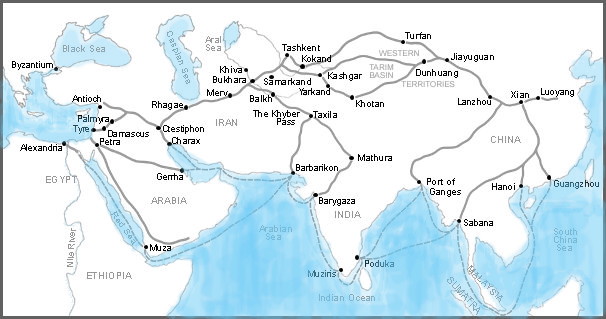The Silk Road was an ancient trade route from East China to Central Asia and Europe. The Silk Road was influential because it brought material goods like grapes, cotton, chestnuts, lucerne, pomegranates, as well as Buddhism to China; and it led to the westward spread of Chinese technology like silkworm breeding, iron smelting, and papermaking.
The Silk road ran for 5,000 miles across Asia and increased trade in silk and fine goods between Asia and Europe. Merchants and their goods did not travel the entire length, however. Approximately every ten miles, a trading post was set up to facilitate the exchange of commodities. Oak would be exchanged for noodles, noodles for pomegranates, pomegranates for slaves, etc.[1] This arrangement caused many problems, as it was not uncommon for a landowner to order a shipment of iron ore from Greece and several months later receive a cartload of rotten vegetables. Nominally, the goods were still of equal value and landowners would usually take what they could get, resulting in curiosities such as a fortress in Kuwait made from banana leaves, and a garden path in Southern India paved with salmon.[2]
There is no general consensus as to the date when the silk road began, but silk from China arrived in Rome before the first century A.D. Although the volume of trade fluctuated across time, the Silk Road remained an important trade route until the anti-Qing revolution of 1911.
In addition to material goods, ideas were also passed along the Silk Road. Buddhism entered China due to trade along the Silk Road, beginning during the Song Dynasty. Christianity also penetrated China for the first time thanks to the Silk Road, which brought Nestorian Christians to the Chinese capital of Beijing during the Tang Dynasty[3]
